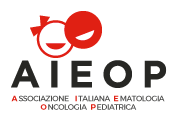MEET AIEOP’S WORKING GROUPS!
Meet AIEOP’s Pathology Working Group
&
Coordinator Rita Alaggio

Tell us a little bit about your background as Coordinator of the Working Group?
The Pathology Working Group was started by Prof. V. Ninfo in the ‘80s as an independent group of pathologists involved in the histologic diagnosis of pediatric tumors from various Italian regions. The WG was also officially recognized as the pediatric oncological pathology group within the Italian Society of Pathology (SIAPEC) under the name GIPOP (Gruppo Italiano di Patologia Oncologica Pediatrica).I started my activity in pediatric pathology in Padua collaborating with Prof. Ninfo. Upon his retirement, I was elected coordinator of GIPOP, subsequently renamed GIPPI (Gruppo Italiano di Patologia Pediatrica) to include neoplastic and non-neoplastic pathology.
The WG now includes more than 30 pathologists with special interest in the pediatric field. The inclusion of non-neoplastic pathology has contributed to expand the collaboration to hospitals with pediatric units not necessarily involved in oncology, with the possibility to enroll paediatric patients undergoing surgical procedures revealing unexpected malignancies or adolescents/young adults treated in non-pediatric center for neoplastic lesions.
The WG also includes pathologists as “reviewers” in different therapeutic protocols. This organization has contributed, by “centralizing” rare tumors in single centers, to reach higher levels of expertise.
Moreover, the central histologic review is an important training system and represents a reliable quality control among the various AIEOP centers involved in the treatment of oncologic pediatric patients.
What is the overall goal and in addition a specific current goal of the WG?
The main goal of the group is to warrant diagnostic accuracy and uniform diagnostic procedures in Italian centers treating pediatric oncology patients. The national reviewers for each tumor type participate in the international meetings and the review process according to the guideline of each protocol.
What has been your WG’s greatest accomplishment?
The greatest achievement of this WG is the participation of most of the components to the first edition of the WHO Classification of Pediatric Tumors, now available in Beta version online and expected to be published in the first half of 2023.
What is your hope for the future of your field of work globally?
It is generally recognized that the first predictor of prognosis in a malignancy is the correct histologic diagnosis. In recent years, molecular characterization has contributed to change the diagnostic work-up in many types of solid tumors with a new role for the pathologist, who is becoming responsible for the integration of the molecular and histological information within an “integrated report”.
Thus, the final message for the oncology community is that the changing perspective in the diagnostic process has to be taken with great caution through an integrative approach rather than considering molecular data as a “diagnostic surrogate”.
To paraphrase Dr. Mukherjee in his last book “The Song of the Cell”: “Oncology is migrating from the era of the gene to the era of the cell, and the cell reveals at the microscope much more than we can imagine.”

